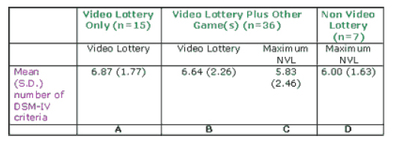The WAGER, Vol. 6 (44) – The Games We Play: Gambling Preferences and Severity of Pathology
Morgan, Kofoed, Buchkoski, & Carr (1996) suggest that video lottery (VL) gambling is “a powerful gambling stimulus” and that there is a relationship between this stimulus and the severity of one’s gambling pathology. Although the authors are careful to point out that their results do not establish a cause and effect relationship, Morgan et al. (1996) explored three aspects of gambling behavior that may reveal an underlying relationship between game preference and pathology: (1) recent gambling activity, (2) the most money lost on one occasion, and (3) the number of DSM-IV criterion problems associated with different types of games. This Wager reviews the relationship between the number of DSM-IV criteria met and the individuals’ gambling patterns.
The researchers recruited fifty-eight South Dakota residents (51 male, 7 female) in treatment for substance addiction who scored a minimum of five on the South Oaks Gambling Screen (Lesieur & Blume, 1987). The participants were grouped depending on pathological gambling by type of game: (1) Video Lottery Only (VLO), (2) Video Lottery and at least one other type of game (VL+), and (3) No Video Lottery (NVL). Morgan et al. (1996) hypothesized that pathological video lottery gambling would result in significantly more DSM-IV problems than other types of games. The researchers tested this hypothesis by comparing the average total criteria met for video lottery gambling to the average maximum number of criteria met for other non-video lottery games.
An independent-groups, separate variance t-test found that the mean number of criteria met for video lottery gambling was not significantly different between VLOs and VL+s (A v. B; t(33.3)=0.385, p=0.7). Thus, individuals who gambled pathologically on VL and at least one other type of game (VL+s) did not report more problems due to VL play than individuals who gambled pathologically on VL only (VLOs). Using the same test, the mean maximum number of criteria met by NLVs for any non-VL game did not differ from the mean maximum non-VL game among VL+s (D v. C; t(12)=0.225, p=0.83). Thus, individuals who gambled pathologically on VL and non-VL games (VL+s) did not differ from individuals who only gambled pathologically on non-VL games (NVLs) in the number of DSM-IV criteria met for non-VL games. In support of the researchers’ hypothesis, a paired sample t-test revealed that for VL+s the number of criteria reached for VL playing was significantly greater than the maximum number of criteria reached for non-VL games (B v. C; t(35)=2.68 p=0.01).
Morgan et al. (1996) suggested that satisfying more DSM-IV criteria reflected more severe pathological gambling. Accordingly, the authors concluded that their study’s results suggested that pathological video lottery play was associated with an increased severity. The conclusion was supported by the within-group difference between VL and non-VL severity among VL+s. However, other study outcomes failed to support this hypothesis. Following the author’s proposition, we would expect that individuals who play VL games pathologically would report elevated levels of pathology relative to people whose problems are related to non-VL play. Both VLOs and VL+s would have more severe pathology than NVLs. The authors did not report these comparisons. Secondary analyses conducted by the WAGER followed the study’s strategy and used independent-groups separate variance t-tests to compare VLO to NVL and VL+ to NVL. Neither test was significant (A v. D; t(12)=1.34, p=0.28; B v. D; t(11)=0.88, p=0.39).
In sum, no statistically significant between-group differences in severity of pathology were apparent. Importantly, the NVL group had an N of only 7. The failure to find statistically significant differences for comparisons involving this group might have been the result of insufficient statistical power to identify these differences due to the small number of subjects.
In addition to the statistical limitations, some methodological and logical limitations exist. First, the small numbers of participants in this study were predominantly males in substance abuse treatment programs. Thus, the stability and generalizability of the effects are uncertain. Second, Morgan et al. (1996) assume that large numbers of DSM-IV criteria are indicative of more severe pathology. However, this is not necessarily the case. The severity of problem behavior within each of the DSM-IV criteria is not taken into account. For example, an individual who meets only four criteria, but who satisfies the conditions of these criteria more extremely than the rest of the sample, might be the most severely pathological individual in the sample.
While these methodological problems represent important concerns, Morgan et al. (1996) do an admirable job of highlighting game preferences as an issue in need of further study. As they note, the majority of individuals who sought help in the sampled treatment programs reported video lottery gambling as their game of choice. However, when investigators attempt to link gaming preferences with pathology, they must consider the severity of individual gambling problems, not merely the number of problems. Further, these problems must be examined in a study with greater statistical power. Until then, the authors’ suggestion that video lottery games promote more severe pathology must remain as speculation.
References
Lesieur, H. R.. & Blume, S. B. (1987). The South Oaks Gambling Screen (SOGS): A new instrument for the identification of pathological gamblers. American Journal of Psychiatry, 144, 1184-1188.
Morgan, T., Kofoed, L., Buchkoski, J., & Carr, R. D. (1996). Video lottery gambling: Effects on pathological gamblers seeking treatment in South Dakota. Journal of Gambling Studies, 12(4), 451-460.
The WAGER is a public education project of the Division on Addictions at Harvard Medical
School. It is funded, in part, by the National Center for Responsible Gaming, the
Massachusetts Department of Public Health, the Addiction Technology Transfer Center of
New England, the Substance Abuse and Mental Health Services Administration, and the
Center for Substance Abuse Treatment.
